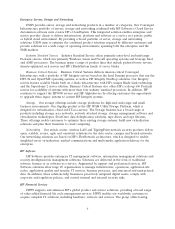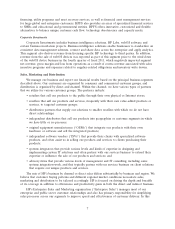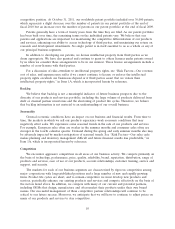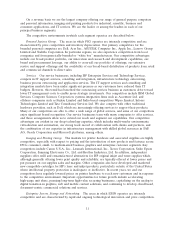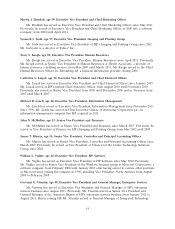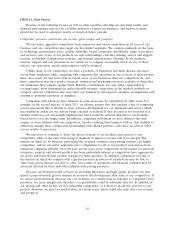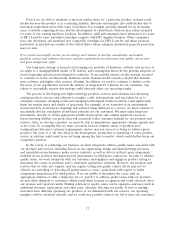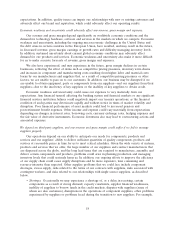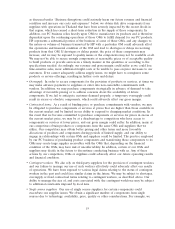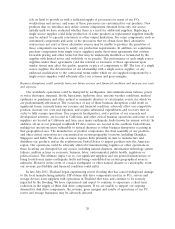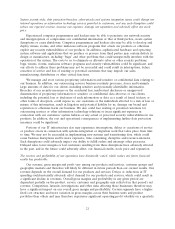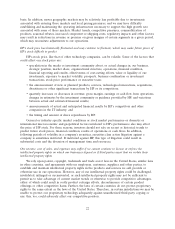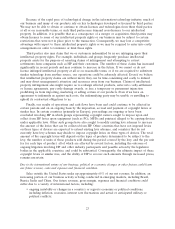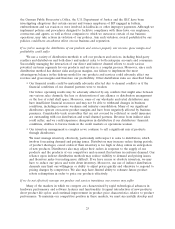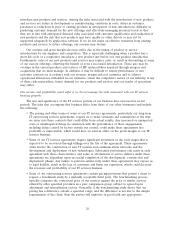HP 2011 Annual Report Download - page 24
Download and view the complete annual report
Please find page 24 of the 2011 HP annual report below. You can navigate through the pages in the report by either clicking on the pages listed below, or by using the keyword search tool below to find specific information within the annual report.ITEM 1A. Risk Factors.
Because of the following factors, as well as other variables affecting our operating results, past
financial performance may not be a reliable indicator of future performance, and historical trends
should not be used to anticipate results or trends in future periods.
Competitive pressures could harm our revenue, gross margin and prospects.
We encounter aggressive competition from numerous and varied competitors in all areas of our
business, and our competitors may target our key market segments. We compete primarily on the basis
of technology, performance, price, quality, reliability, brand, reputation, distribution, range of products
and services, ease of use of our products, account relationships, customer training, service and support,
security, availability of application software, and Internet infrastructure offerings. If our products,
services, support and cost structure do not enable us to compete successfully based on any of those
criteria, our operations, results and prospects could be harmed.
Unlike many of our competitors, we have a portfolio of businesses and must allocate resources
across these businesses while competing with companies that specialize in one or more of these product
lines. As a result, we may invest less in certain areas of our businesses than our competitors do, and
these competitors may have greater financial, technical and marketing resources available to them than
our businesses that compete against them. Industry consolidation also may affect competition by
creating larger, more homogeneous and potentially stronger competitors in the markets in which we
compete, and our competitors also may affect our business by entering into exclusive arrangements with
existing or potential customers or suppliers.
Companies with whom we have alliances in some areas may be competitors in other areas. For
example, in the second quarter of fiscal 2011, an alliance partner that also markets a line of competing
servers announced that it intends to cease software development for our Itanium-based servers, which
has resulted in orders for our servers being canceled or delayed. If that decision is not reversed or if
another solution is not successfully implemented, there would be reduced demand for our Itanium-
based servers over the longer term. In addition, companies with whom we have alliances also may
acquire or form alliances with our competitors, thereby reducing their business with us. Any inability to
effectively manage these complicated relationships with alliance partners could have an adverse effect
on our results of operations.
We may have to continue to lower the prices of many of our products and services to stay
competitive, while at the same time trying to maintain or improve revenue and gross margin. The
markets in which we do business, particularly the personal computer and printing markets, are highly
competitive, and we encounter aggressive price competition for all of our products and services from
numerous companies globally. Over the past several years, price competition in the market for personal
computers, printers and related products has been particularly intense as competitors have aggressively
cut prices and lowered their product margins for these products. In addition, competitors in some of
the markets in which we compete with a greater presence in lower-cost jurisdictions may be able to
offer lower prices than we are able to offer. Our results of operations and financial condition may be
adversely affected by these and other industry-wide pricing pressures.
Because our business model is based on providing innovative and high quality products, we may
spend a proportionately greater amount on research and development than some of our competitors. If
we cannot proportionately decrease our cost structure on a timely basis in response to competitive price
pressures, our gross margin and, therefore, our profitability could be adversely affected. In addition, if
our pricing and other factors are not sufficiently competitive, or if there is an adverse reaction to our
product decisions, we may lose market share in certain areas, which could adversely affect our revenue
and prospects.
16


